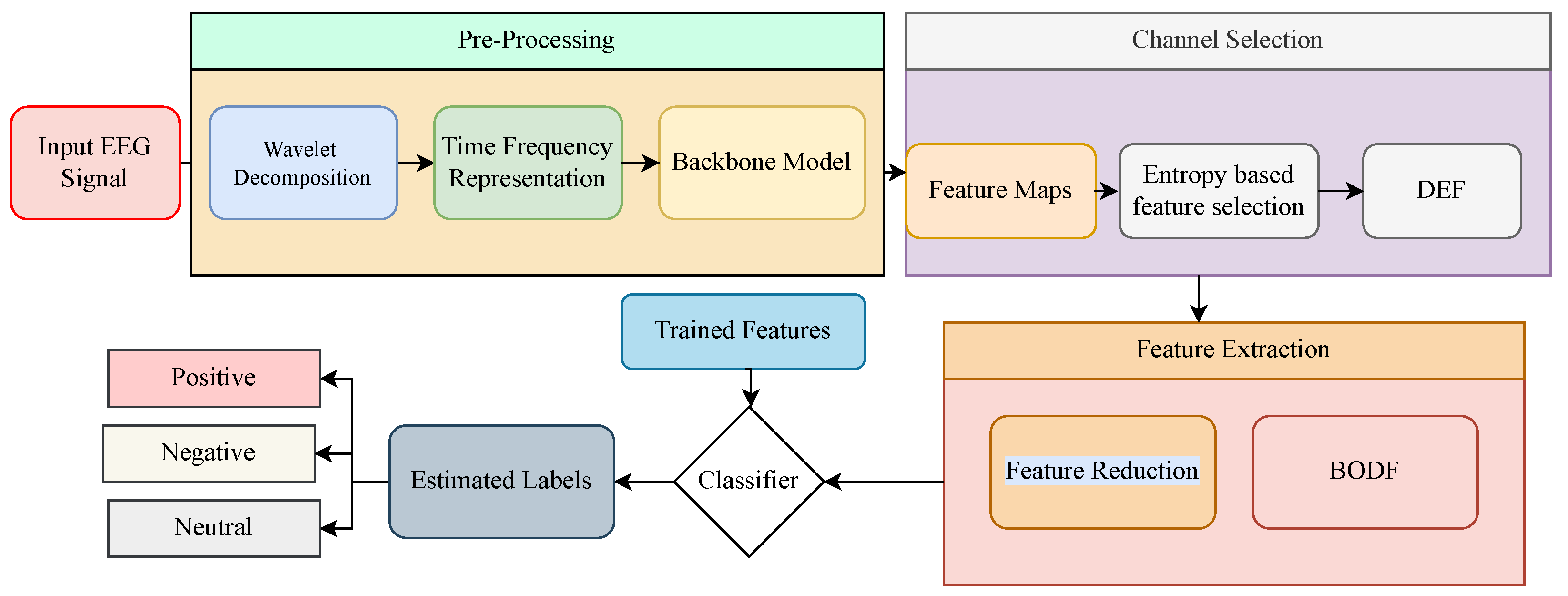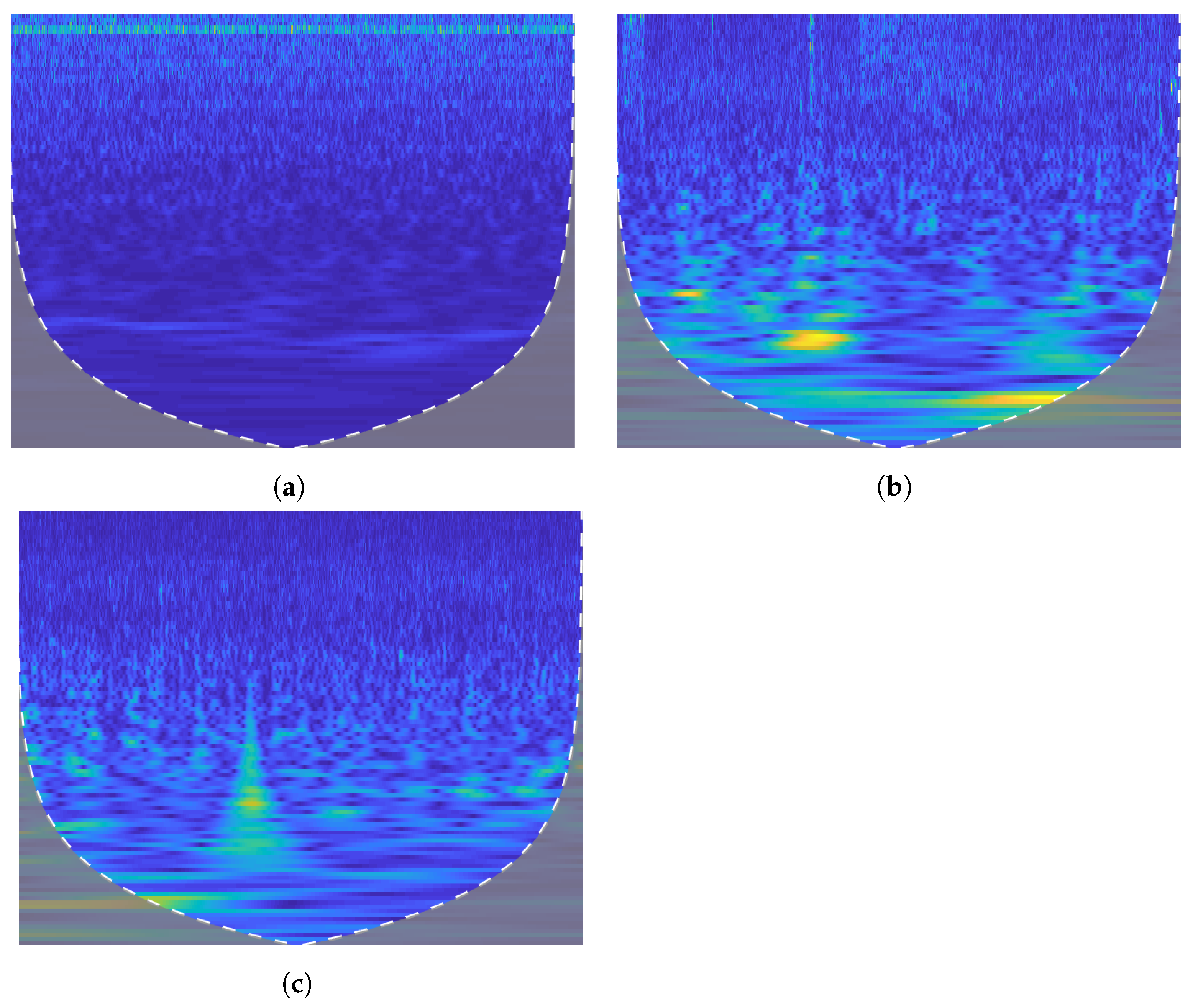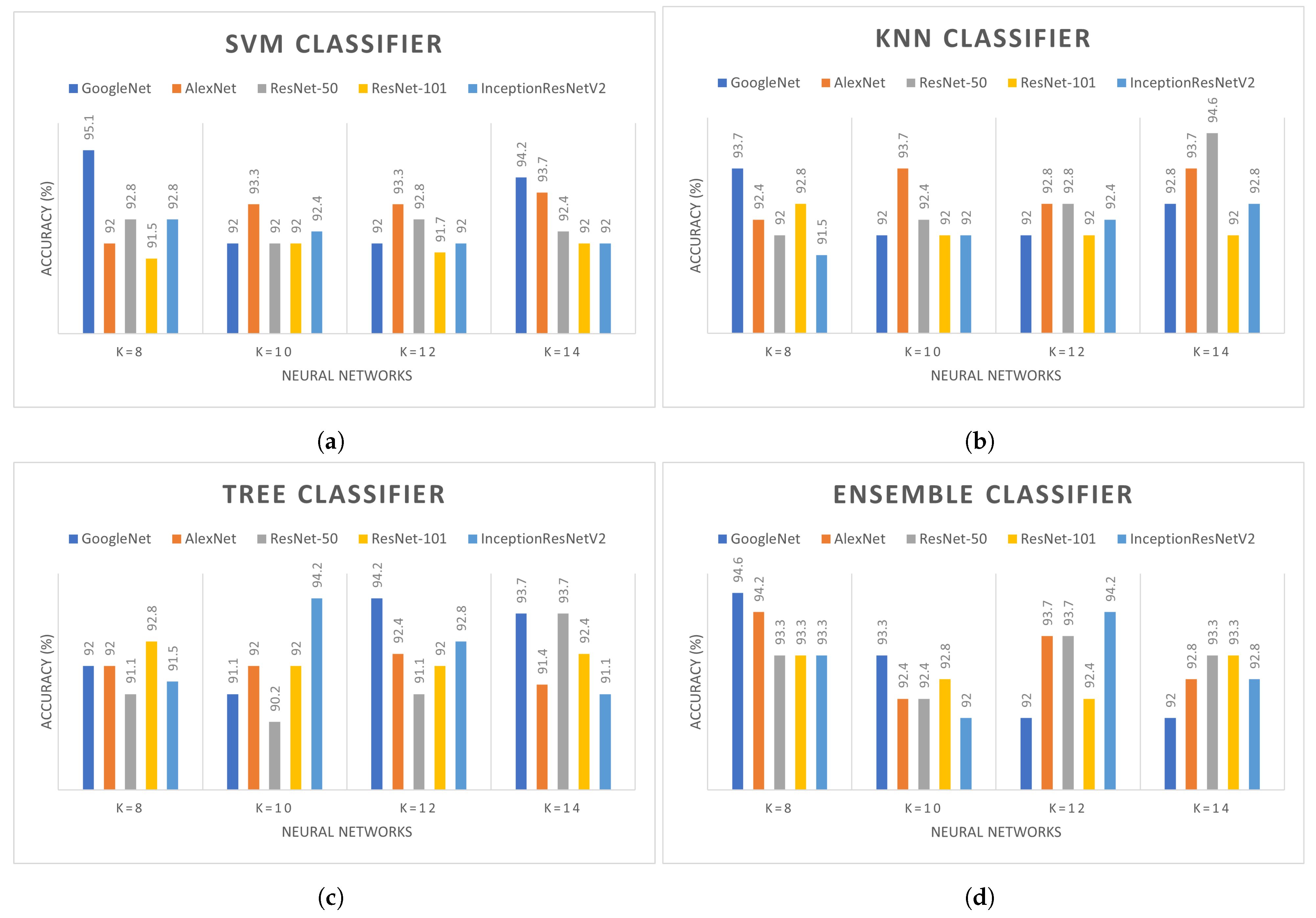A Hybrid Hand-Crafted and Deep Neural Spatio-Temporal EEG Features Clustering Framework for Precise Emotional Status Recognition
Abstract
:1. Introduction
2. Related ork
3. Proposed Methodology
3.1. Decomposition into Time-Frequency Spectrum
3.2. Feature Extraction
3.3. Differential Entropy-Based Features Selection
3.4. Bag of Deep Features (BoDF)
3.5. Dataset Description
- The emotion detection was recorded for short clips in order to avoid the unnatural behavior of the human.
- The video explains the scenario of itself.
- Only one emotion was recorded at the time of watching the video.
4. Results
4.1. Performance Evaluation on Different Deep Learning Models
4.2. Comparison with State-of-the-Art Methods
5. Conclusions
Author Contributions
Funding
Institutional Review Board Statement
Informed Consent Statement
Data Availability Statement
Conflicts of Interest
Abbreviations
| BoDF | Bag of Deep Features |
| CS | Cross Subject |
| CSP | Common Spatial Patterns |
| CWT | Wavelet Transform |
| DE | Differential Entropy |
| DECS | Differential Entropy-Based Channel Selection |
| DWT | Discrete Wavelet Transform |
| EC | Evolutionary Computation |
| EEG | Electroencephalogram signals |
| EMD | Empirical Mode Decomposition |
| EMG | Electromyography |
| ER-WTF | Emotion Recognition Through Wavelet Transforms |
| fMRI | Functional Magnetic Resonance Imaging |
| KNN | K-nearest Neighbours |
| MIC | Motor Imagery Classification |
| MM | Multi-model learning |
| 1D | One-Dimensional |
| ReLU | Rectified Linear Activation |
| RFE | Recursive Emotion Feature Elimination |
| SJTU | Shanghai Jiaotong University |
| STRNN | Spatial-Temporal Recurrent Neural Networks |
| SVM | Support Vector Machine |
| STFT | Short-Time Fourier transform |
| 2D | two-dimensional |
| WPD | Wavelet Packet Decomposition |
References
- Hunter, P.G.; Schellenberg, E.G.; Griffith, A.T. Misery loves company: Mood-congruent emotional responding to music. Emotion 2011, 11, 1068–1072. [Google Scholar] [CrossRef] [PubMed] [Green Version]
- Soleymani, M.; Larson, M.; Pun, T.; Hanjalic, A. Corpus development for affective video indexing. IEEE Trans. Multimed. 2014, 16, 1075–1089. [Google Scholar] [CrossRef] [Green Version]
- Joho, H.; Staiano, J.; Sebe, N.; Jose, J. Looking at the viewer: Analysing facial activity to detect personal highlights of multimedia contents. Multimed. Tools Appl. 2010, 51, 505–523. [Google Scholar] [CrossRef]
- Adolphs, R.; Tranel, D.; Damasio, H.; Damasio, A. Impaired recognition of emotion in facial expressions following bilateral damage to the human amygdala. Nature 1994, 372, 669–672. [Google Scholar] [CrossRef]
- Chatterjee, M.; Zion, D.J.; Deroche, M.L.; Burianek, B.A.; Limb, C.J.; Goren, A.P.; Kulkarni, A.M.; Christensen, J.A. Voice emotion recognition by cochlear-implanted children and their normally-hearing peers. Hear. Res. 2015, 322, 151–162. [Google Scholar] [CrossRef] [Green Version]
- Ross, P.D.; Polson, L.; Grosbras, M.H. Developmental Changes in Emotion Recognition from Full-Light and Point-Light Displays of Body Movement. PLoS ONE 2012, 7, e44815. [Google Scholar] [CrossRef]
- Zhong, Y.; Zhao, M.; Wang, Y.; Yang, J.; Zhan, J. Recognition of emotions using multimodal physiological signals and an ensemble deep learning model. Comput. Meth. Prog. Bio. 2017, 140, 93–110. [Google Scholar]
- Abadi, M.K.; Kia, M.; Subramanian, R.; Avesani, P.; Sebe, N. Decoding affect in videos employing the MEG brain signal. In Proceedings of the 2013 10th IEEE International Conference and Workshops on Automatic Face and Gesture Recognition (FG), Shanghai, China, 22–26 April 2013; pp. 1–6. [Google Scholar]
- Lottridge, D.; Chignell, M.; Jovicic, A. Affective interaction: Understanding, evaluating, and designing for human emotion. Rev. Hum. Factors Ergon. 2011, 7, 197–217. [Google Scholar] [CrossRef]
- Izard, C.E.; Libero, D.Z.; Putnam, P.; Haynes, O.M. Stability of emotion experiences and their relations to traits of personality. J. Personal. Soc. Psychol. 1993, 64, 847. [Google Scholar] [CrossRef]
- Lang, P.J. The emotion probe: Studies of motivation and attention. Am. Psychol. 1995, 50, 372. [Google Scholar] [CrossRef]
- Ekman, P.E.; Davidson, R.J. The Nature of Emotion: Fundamental Questions; Oxford University Press: Oxford, UK, 1994. [Google Scholar]
- Norman, D.A.; Ortony, A.; Russell, D.M. Affect and machine design: Lessons for the development of autonomous machines. IBM Syst. J. 2003, 42, 38–44. [Google Scholar] [CrossRef]
- Zhang, T.; Zheng, W.; Cui, Z.; Zong, Y.; Li, Y. Spatial-Temporal Recurrent Neural Network for Emotion Recognition. IEEE Trans. Cybern. 2019, 49, 839–847. [Google Scholar] [CrossRef] [PubMed] [Green Version]
- Li, X.; Song, D.; Zhang, P.; Zhang, Y.; Hou, Y.; Hu, B. Exploring EEG features in cross-subject emotion recognition. Front. Neurosci. 2018, 12, 162. [Google Scholar] [CrossRef] [PubMed] [Green Version]
- Aricò, P.; Borghini, G.; Flumeri, G.D.; Sciaraffa, N.; Babiloni, F. Passive BCI beyond the lab: Current trends and future directions. Physiol. Meas. 2018, 39, 08TR02. [Google Scholar] [CrossRef]
- Keltiner, D.; Lewis, P.E.M.; Jones, J.M.H. (Eds.) Facial Expression of Emotion, Hand Book of Emotions; Gilford Press: New York, NY, USA, 2000; pp. 236–249. [Google Scholar]
- Aloise, F.; Aricò, P.; Schettini, F.; Salinari, S.; Mattia, D.; Cincotti, F. Asynchronous gaze-independent event-related potential-based brain–Computer interface. Artif. Intell. Med. 2013, 59, 61–69. [Google Scholar] [CrossRef]
- Anagnostopoulos, C.-N.; Iliou, T.; Giannoukos, I. Features and classifiers for emotion recognition from speech: A survey from 2000 to 2011. Artif. Intell. Rev. 2012, 43, 155–177. [Google Scholar] [CrossRef]
- Lotte, F.; Guan, C. Regularizing Common Spatial Patterns to Improve BCI Designs: Unified Theory and New Algorithms. IEEE Trans. Biomed. Eng. 2011, 58, 355–362. [Google Scholar] [CrossRef] [Green Version]
- Coogan, C.G.; He, B. Brain-Computer Interface Control in a Virtual Reality Environment and Applications for the Internet of Things. IEEE Access 2018, 6, 10840–10849. [Google Scholar] [CrossRef]
- Song, L.; Epps, J. Classifying EEG for Brain-Computer Interface: Learning Optimal Filters for Dynamical System Features. Comput. Intell. Neurosci. 2007, 2007, 057180. [Google Scholar] [CrossRef] [Green Version]
- Mert, A.; Akan, A. Emotion recognition from EEG signals by using multivariate empirical mode decomposition. Pattern Anal. Appl. 2016, 21, 81–89. [Google Scholar] [CrossRef]
- Chondro, P.; Haq, Q.M.U.; Ruan, S.J.; Li, L.P.H. Transferable architecture for segmenting maxillary sinuses on texture-enhanced occipitomental view radiographs. Mathematics 2020, 8, 768. [Google Scholar] [CrossRef]
- Sadiq, M.T.; Yu, X.; Yuan, Z.; Fan, Z.; Rehman, A.U.; Li, G.; Xiao, G. Motor Imagery EEG Signals Classification Based on Mode Amplitude and Frequency Components Using Empirical Wavelet Transform. IEEE Access 2019, 7, 127678–127692. [Google Scholar] [CrossRef]
- Kevric, J.; Subasi, A. Comparison of signal decomposition methods in classification of EEG signals for motor-imagery BCI system. Biomed. Signal Process. Control 2017, 31, 398–406. [Google Scholar] [CrossRef]
- Raheel, A.; Majid, M.; Anwar, S.M. Facial expression recognition based on electroencephalography. In Proceedings of the 2019 2nd International Conference on Computing, Mathematics and Engineering Technologies (iCoMET), Sukkur, Pakistan, 30–31 January 2019; pp. 1–5. [Google Scholar]
- Nguyen, B.T.; Trinh, M.H.; Phan, T.V.; Nguyen, H.D. An efficient real-time emotion detection using camera and facial landmarks. In Proceedings of the 2017 Seventh International Conference on Information Science and Technology (ICIST), Da Nang, Vietnam, 16–19 April 2017. [Google Scholar] [CrossRef]
- Chao, H.; Dong, L.; Liu, Y.; Lu, B. Emotion Recognition from Multiband EEG Signals Using CapsNet. Sensors 2019, 19, 2212. [Google Scholar] [CrossRef] [PubMed] [Green Version]
- Faust, O.; Hagiwara, Y.; Hong, T.J.; Lih, O.S.; Acharya, U.R. Deep learning for healthcare applications based on physiological signals: A review. Comput. Methods Programs Biomed. 2018, 161, 1–13. [Google Scholar] [CrossRef] [PubMed]
- Gupta, V.; Chopda, M.D.; Pachori, R.B. Cross-Subject Emotion Recognition Using Flexible Analytic Wavelet Transform From EEG Signals. IEEE Sens. J. 2019, 19, 2266–2274. [Google Scholar] [CrossRef]
- Medhat, W.; Hassan, A.; Korashy, H. Sentiment analysis algorithms and applications: A survey. Ain Shams Eng. J. 2014, 5, 1093–1113. [Google Scholar] [CrossRef] [Green Version]
- Yue, L.; Chen, W.; Li, X.; Zuo, W.; Yin, M. A survey of sentiment analysis in social media. Knowl. Inf. Syst. 2019, 60, 617–663. [Google Scholar] [CrossRef]
- Gore, R.J.; Diallo, S.; Padilla, J. You are what you tweet: Connecting the geographic variation in America’s obesity rate to twitter content. PLoS ONE 2015, 10, e0133505. [Google Scholar] [CrossRef] [Green Version]
- Padilla, J.J.; Kavak, H.; Lynch, C.J.; Gore, R.J.; Diallo, S.Y. Temporal and spatiotemporal investigation of tourist attraction visit sentiment on Twitter. PLoS ONE 2018, 13, e0198857. [Google Scholar] [CrossRef] [Green Version]
- Mitchell, L.; Frank, M.R.; Harris, K.D.; Dodds, P.S.; Danforth, C.M. The geography of happiness: Connecting twitter sentiment and expression, demographics, and objective characteristics of place. PLoS ONE 2013, 8, e64417. [Google Scholar] [CrossRef] [PubMed] [Green Version]
- Frank, M.R.; Mitchell, L.; Dodds, P.S.; Danforth, C.M. Happiness and the patterns of life: A study of geolocated tweets. Sci. Rep. 2013, 3, 2625. [Google Scholar] [CrossRef] [PubMed] [Green Version]
- Asghar, M.A.; Khan, M.J.; Amin, Y.; Rizwan, M.; Rahman, M.; Badnava, S.; Mirjavadi, S.S. EEG-Based Multi-Modal Emotion Recognition using Bag of Deep Features: An Optimal Feature Selection Approach. Sensors 2019, 19, 5218. [Google Scholar] [CrossRef] [Green Version]
- Nakisa, B.; Rastgoo, M.N.; Tjondronegoro, D.; Chandran, V. Evolutionary computation algorithms for feature selection of EEG-based emotion recognition using mobile sensors. Expert Syst. Appl. 2018, 93, 143–155. [Google Scholar] [CrossRef] [Green Version]
- Szegedy, C.; Liu, W.; Jia, Y.; Sermanet, P.; Reed, S.; Anguelov, D.; Erhan, D.; Vanhoucke, D.V.; Rabinovich, A. Going deeper with convolutions. In Proceedings of the IEEE Conference on Computer Vision and Pattern Recognition, Boston, MA, USA, 7–12 June 2015; pp. 1–9. [Google Scholar]
- Li, F.; Zhang, Z.; Jin, C. Feature selection with partition differentiation entropy for large-scale data sets. Inf. Sci. 2016, 329, 690–700. [Google Scholar] [CrossRef]
- Zheng, W.L.; Lu, B.L. Investigating critical frequency bands and channels for EEG-based emotion recognition with deep neural networks. IEEE Trans. Auton. Ment. Dev. 2015, 7, 162–175. [Google Scholar] [CrossRef]






| Methods | Features | Dataset | No. of Channels | Classifier |
|---|---|---|---|---|
| MIC [25] | MFM | DEAP | 18 | CapsNet |
| ER-WTF [31] | MFCC | SEED | SVM | |
| Random Forest | ||||
| DEAP | 6 | Random Forest | ||
| EMD [23] | MEMD | DEAP | 12 | ANN |
| KNN | ||||
| STRNN [14] | STRNN | SEED | 62 | CNN |
| CS [15] | RFE | SEED | 18 | SVM |
| DEAP | 12 | SVM | ||
| EC [39] | DE | DEAP | 32 | PNN |
| MM [38] | BODF | SEED | 62 | SVM |
| KNN | ||||
| DEAP | 32 | SVM | ||
| KNN | ||||
| Our Work | DEFS | SEED | 26 | SVM |
| KNN | ||||
| Tree | ||||
| Ensemble |
| No. | Emotion Label | Clips from Movie Source |
|---|---|---|
| 1 | Negative | Tangshan Earthquake |
| 2 | Negative | 1942 |
| 3 | Positive | Lost in Thailand |
| 4 | Positive | Flirting scholar |
| 5 | Positive | Just another Pandora’s Box |
| 6 | Neutral | World Heritage in China |
| Neural Networks | Channels | Classifiers | Kernals | Accuracy (%) |
|---|---|---|---|---|
| GoogleNet | 26 | SVM | Cubic | 96.7 |
| kNN | Fine | 95.3 | ||
| Tree | Medium | 95.8 | ||
| Ensemble | Subspace KNN | 96.2 | ||
| AlexNet | 28 | SVM | Fine Gaussian | 95.3 |
| kNN | Weighted | 96.2 | ||
| Tree | Medium/Fine | 94.0 | ||
| Ensemble | Subspace KNN | 95.8 | ||
| Resnet-50 | 40 | SVM | Fine Gaussian | 94.4 |
| kNN | Weighted | 96.2 | ||
| Tree | Medium/Fine | 95.3 | ||
| Ensemble | Subspace KNN | 95.3 | ||
| Resnet-101 | 29 | SVM | Fine Gaussian | 94.0 |
| kNN | Weighted | 94.4 | ||
| Tree | Medium/Fine | 94.4 | ||
| Ensemble | Bagged Trees | 94.9 | ||
| InceptionresnetV2 | 32 | SVM | Cubic | 94.4 |
| kNN | Weighted/Fine | 94.4 | ||
| Tree | Medium/Fine | 95.8 | ||
| Ensemble | Subspace KNN | 95.8 |
| Methods | Features | Dataset | No. of Channels | Classifier | Accuracy (%) |
|---|---|---|---|---|---|
| MIC [25] | MFM | DEAP | 18 | CapsNet | 68.2 |
| ER-WTF [31] | MFCC | SEED | 6 | SVM | 83.5 |
| Random Forest | 72.07 | ||||
| DEAP | 6 | Random Forest | 72.07 | ||
| EMD [23] | MEMD | DEAP | 12 | ANN | 75 |
| KNN | 67 | ||||
| STRNN [14] | STRNN | SEED | 62 | CNN | 89.5 |
| CS [15] | RFE | SEED | 18 | SVM | 90.4 |
| DEAP | 12 | SVM | 60.5 | ||
| EC [39] | DE | DEAP | 32 | PNN | 79.3 |
| MM [38] | BODF | SEED | 62 | SVM | 93.8 |
| KNN | 91.4 | ||||
| DEAP | 32 | SVM | 77.4 | ||
| KNN | 73.6 | ||||
| Our Work | DEFS | SEED | 26 | SVM | 96.7 |
| KNN | 95.3 | ||||
| Tree | 95.8 | ||||
| Ensemble | 96.2 |
Publisher’s Note: MDPI stays neutral with regard to jurisdictional claims in published maps and institutional affiliations. |
© 2022 by the authors. Licensee MDPI, Basel, Switzerland. This article is an open access article distributed under the terms and conditions of the Creative Commons Attribution (CC BY) license (https://creativecommons.org/licenses/by/4.0/).
Share and Cite
Haq, Q.M.u.; Yao, L.; Rahmaniar, W.; Fawad; Islam, F. A Hybrid Hand-Crafted and Deep Neural Spatio-Temporal EEG Features Clustering Framework for Precise Emotional Status Recognition. Sensors 2022, 22, 5158. https://doi.org/10.3390/s22145158
Haq QMu, Yao L, Rahmaniar W, Fawad, Islam F. A Hybrid Hand-Crafted and Deep Neural Spatio-Temporal EEG Features Clustering Framework for Precise Emotional Status Recognition. Sensors. 2022; 22(14):5158. https://doi.org/10.3390/s22145158
Chicago/Turabian StyleHaq, Qazi Mazhar ul, Leehter Yao, Wahyu Rahmaniar, Fawad, and Faizul Islam. 2022. "A Hybrid Hand-Crafted and Deep Neural Spatio-Temporal EEG Features Clustering Framework for Precise Emotional Status Recognition" Sensors 22, no. 14: 5158. https://doi.org/10.3390/s22145158








